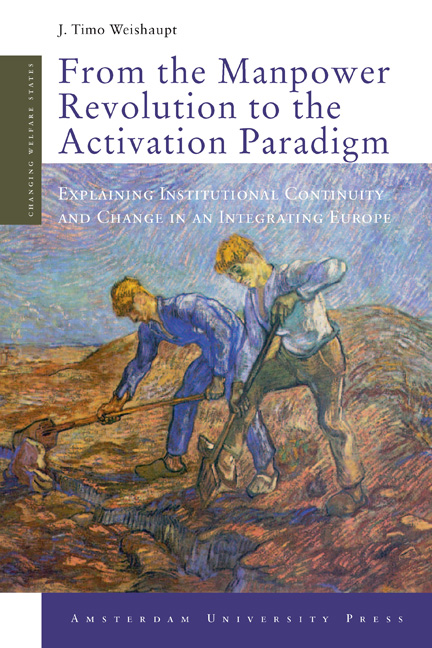 From the Manpower Revolution to the Activation Paradigm
From the Manpower Revolution to the Activation Paradigm Book contents
- Frontmatter
- Contents
- List of Boxes, Figures and Tables
- Abbreviations
- Acknowledgements
- I Introduction
- II Theoretical Approach
- Part I Origin and Crisis of European Labour Market Policy Regimes
- Part II The Emergence of the Activation Paradigm
- List of Interviews and Personal Conversations
- Notes
- Bibliography
- Index
- Changing Welfare States
- Frontmatter
- Contents
- List of Boxes, Figures and Tables
- Abbreviations
- Acknowledgements
- I Introduction
- II Theoretical Approach
- Part I Origin and Crisis of European Labour Market Policy Regimes
- Part II The Emergence of the Activation Paradigm
- List of Interviews and Personal Conversations
- Notes
- Bibliography
- Index
- Changing Welfare States
Summary
The Research Questions
With the burst of the American housing bubble in late 2007 and the subsequent financial crisis that reached its climax with the collapse of Lehman Brothers in September 2008, skyrocketing unemployment and full-blown economic recessions became a global phenomenon in 2009. While the economic, political and social repercussions were felt worldwide, European policymakers were in particular reminded of both the vulnerability of their deeply institutionalised social welfare systems and – at the same time – the importance of adequate institutions, being able to cope with rising unemployment and growing inequality. This situation, however, is nothing new. Since the age of urbanisation and industrialisation, European nations have, from time to time, been exposed to deep and prolonged economic downturns, resulting in mass unemployment. The Great Depression of the 1930s, the years following the oil crises in 1973 and 1979, and more recently, the recessions after the collapse of the Soviet Union, the first Gulf War, and the European currency crisis in the early 1990s all resulted in significant increases in unemployment levels.
When faced with severe economic, political, and/or social challenges, policymakers begin to “look abroad” to see what other countries are doing (Casey 2009, 103). Already during the creation and expansion of initial welfare state structures in late 19th century, policymakers sent delegates to neighbouring countries in search for institutional alternatives and solutions to pressing problems. Such eff orts to learn from others were substantively improved after World War II (WWII) when the Organisation for Economic Co-operation and Development (OECD) was created in 1960, as an international, mainly European, body to promote policy convergence and to enhance transnational learning. During the 1990s, European policymakers placed even more emphasis on transnational lesson-drawing, not only by initiating the elaborate OECD Jobs Study (1992-1994), but also by launching the European Employment Strategy (EES) in 1997.
Given that policymakers have frequently faced unemployment challenges throughout the 20th and the beginning of the 21st century, and given that they have repeatedly and often systematically been exposed to, or actively solicited, new ideas from abroad, the following questions arise:
(1) Do national labour market policy reform efforts exhibit covariation across Western Europe, and if so, how and why?
(2) What impact, if any, have the recommendations of international organisations such as the OECD and the EU had on national reform agendas?
- Type
- Chapter
- Information
- From the Manpower Revolution to the Activation ParadigmExplaining Institutional Continuity and Change in an Integrating Europe, pp. 21 - 34Publisher: Amsterdam University PressPrint publication year: 2012


